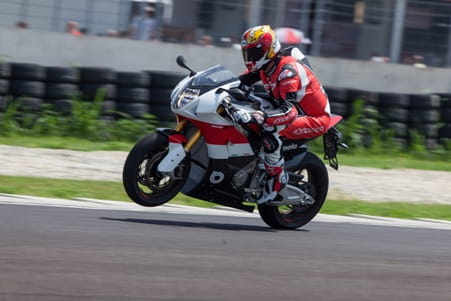
BIMOTA BB3 FIRST TRACK TEST - 'PASSION AND EMOTION'
Bimota is back from the ashes with an all-new hand-built bike powered by a 193bhp BMW S1000RR motor and a Swiss banker-spec price of £28,000. But the question is, is the new BB3 any good? And is Bimota still relevant in 2014? We flew to the bike’s world launch at the Nuvolari in Italy to find out.
Passion and emotion is a phrase you will hear a lot from Bimota. It’s why the new owners with their money made from a variety of ventures including Swiss banking decided to buy the company. As one of the new owners told us: “One day I always wanted to buy a Bimota, I never expected to buy the whole company.”
The historic Italian company, which celebrates its 40th year in 2014, was reborn from the ashes just nine months ago when Daniele Longoni and Marco Chiancianesi bought it for an undisclosed sum.
The Bimota factory staff were literally told on one day that the current owner had some difficulty with running the business and was off. The next day the new guys walked in and took over.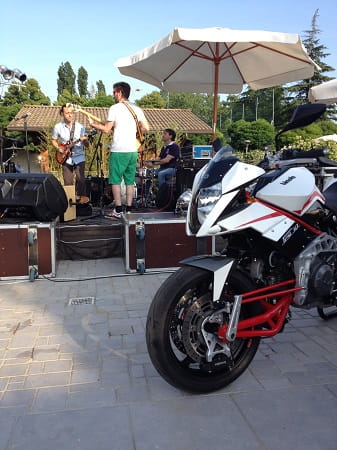
Long-haired former professional footballer Chiancianesi rocked up to the Rimini factory on his first day, took a Bimota DB11 out and rode off to Vallelunga for a track day. Passion and emotion.
He looks like a rock star and sings like one too (he played guitar and sang in his own band at the Bimota Experience Weekend we attended).
It’s that same passion and emotion which lead the new company to take the Bimota BB2 concept, that was shown at the Milan Show in 2012, and turn it into the BB3. It’s the third BMW-powered Bimota in the company’s fourty year history.
The first was a BMW F650-powered sports single in the vein of Ducati’s Supermono in the early nineties. It was quite good in a slow kind of way, with a rev-limiter that almost threw you over the handlebars as it kicked in so violently, but it ate corners like a labrador let loose next to a bowl of chips.
The second was the aforementioned prototype that never made production but went down well at the show.
This, the BB3 is the third and the bike that has already lead Bimota into some serious success so far in the WSBK Evo class this year, including taking a first and second place in the Evo class at Donington in the hands of Ayrton Badovini and Brit Christian Iddon.
Yet despite a well-designed race bike and one of the most experienced teams in the paddock running the bikes, Bimota are yet to score a point in the Evo class because they haven’t built any BB3's for sale.
The bike is fast and obviously capable of winning, but until Bimota show WSBK organisers they have built 125 bikes before the end of July they’re not allowed to score points.
Likely? Only time will tell, and the factory are confident they can hit the deadline. But even to get that far with a new bike in nine months is impressive. Passion and emotion.
So the WSB Evo bikes raced by Badovini and Iddon are based on this, or this is based on the WSB bikes. The £27, 877 (35,000 Euros) Bimota BB3 road bike you see here certainly comes from the right stable then and anyone rich enough to buy one.
Bimota is keen to point out that when you buy a Bimota you’re not just buying a bike, you are buying into the brand. They tell me that a Bimota is not just for the guy who wants to buy a production motorcycle, but for someone who wants to be part of the Bimota family. They want you to come to Rimini to experience the Bimota passion and see, smell and hear where your bike is built.
That passion will cost you some £14,142 more than the amazing BMW S1000RR it’s based on. It needs to be more than good to do that. In my experience, £14,000 can buy a whole lot of passion.
It’s a passion you can definitely feel at the Bimota Experience Weekend in Italy we attended over the weekend. You can get the vibe of Bimota, the staff are mixing with customers new and old and the Bimota owners at the event would bleed red, green and white before riding anything else.
You can’t help but get sucked in by the brand that means so much to die hard motorcyclists. It’s the Lamborghini of the motorcycling world, outrageous, powerful, noisey bikes straight off posters from the brains of Limoncello-powered Italian designers sketching bikes that look like they stepped out of a movie.
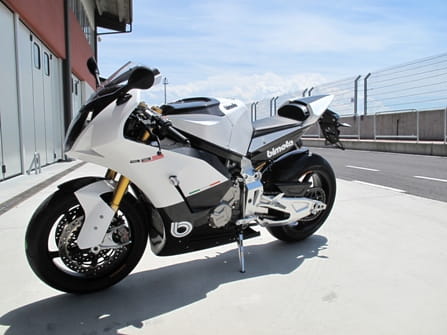
THE STYLING:
Look closely at the BB3 and you can see the passion and emotion coming through, even if initially it doesn’t quite tick all the boxes.
The carbon fibre is some of the best I’ve ever seen. The fairing, mudguard, tail unit, clock surrounds are all made from it. The brakes are the finest Brembo forged ABS front calipers money can buy for a road bike. The Ohlins upside down front forks and the Ohlins rear shock are top-spec and fully adjustable, and the tubular steel trellis frame matched to aluminium machined side plates are a work of art.
The swingarm for instance is aluminium and wouldn’t look out of place in MotoGP. The engine is straight from the best sports bike ever made, as are the electronic traction control, the clocks, the ignition, the fuel-injection system and the switchgear. So far so good.
Yes, as a sum of parts it is beautiful – the swingarm – the frame and the carbon are all stunning. That name means so much too and evokes memories of WSB bikes for the road and stunning innovations like the Tesi’s single-swing arm front-end. The word exotic was invented for Bimota.
But then you get to the styling and here’s where it starts to go a little bit array. Get past the red white and black colour scheme, or the plain white version with carbon-fibre belly pan, and think what it really looks like. For me, the front-end reminds me of an old GSX-R1000 headlamp and manages to feel like a bike designed five years ago.
Compare it to the new breed of edgier styled bikes like the Ducati 899, and the BMW S1000RR it’s based on and it looks dated. It looks a bit soft and that headlight still looks like it’s from an old GSX-R1000. This is a Bimota and its design should be revolutionary like the legends before it – the bikes that are on display at the track. Bimota icons like Tesi, V-due, HB1, KB1, YB11, SB8. Even the ill-fated Mantra and its wood inlay dash. At least that bike made a statement.
I’m struggling to find what this bike would say? “Hi, I’m a slightly heavier, more expensive version of the BMW S1000RR”. Does have a certain ring to it, maybe?
RIDING THE BIMOTA BB3:
It’s no different when you sit on it. The riding position is way more extreme than the BMW S1000RR, that’s expected, it’s what Bimota does. But is it right for now?
The handlebars are low and put quite a lot of weight on your wrists, and the whole bike feels considerably taller than most other sports bikes. The riding position is typically Bimota – extreme. In 2014 sports bikes ranging from the BMW it’s based on to R1’s and S1000RRs can be comfortable as well as work on track, it feels old school.
There’s a BMW standard issue RR rev-counter and switchgear taken straight from the BMW too. The mode switch should allow you to switch between different modes of traction control and braking levels. Sadly the mode selector had been disabled on the bike I rode and could only be set to ‘Road’ setting.
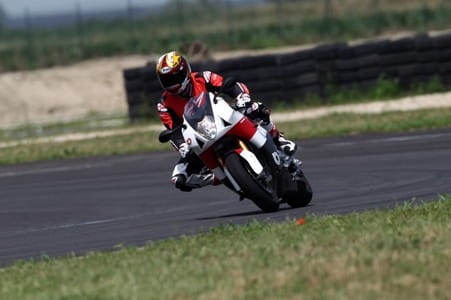
That meant a lot of ABS assistance and a lot of anti-wheelie and traction-control dialled in.
Great on the road, but for a track test in 40 degree heat you really want ‘Slick’ or ‘Race’ mode to free the bike up and explore its potential. Bimota’s aren’t about taking things easy. Equally, the quick shifter on the bike I rode was working intermittently.
It starts like a Beemer, sounds like a Beemer and pulls away like a Beemer, which if you’ve ever experienced means it accelerates like nothing else.
There’s that hard-charging motor which howls through Bimota’s exhaust system and pulls cleanly all the way through to 14,000rpm. It properly adjusts your atmosphere as those 193 horses fight against the electronic devices spoiling the fun. As engines go there is still nothing else built for a road bike that comes anywhere close.
The Tazio Nuvolari circuit is brand new and, and this is the first time it has been used for bikes.
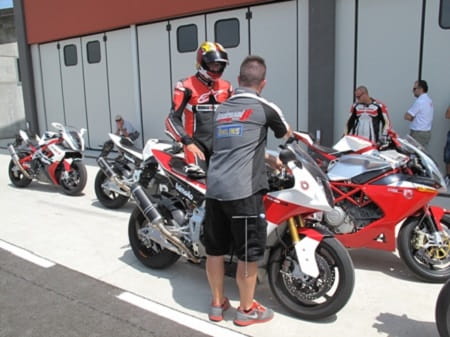
In fourty degree heat the day before we rode, the surface has rippled badly and deformed and there’s oil coming out of the surface. Tracks almost need bedding in, and as it’s a brand new track there’s almost no feel from the surface. To be sure I wasn’t just being a bit shy in corners, I spoke to Bimota WSB rider Christian Iddon about the surface.
He said: “I think there’s probably loads of grip from the tyres, but the problem with the new track is you just can’t feel it from the surface. New surfaces are always like that. If you rode on glass there would be loads of grip but then it would suddenly let go without warning. That’s what you need to watch out for.” As former British Supermoto champion who’s happy to go sideways at every corner, I’ll take his word for it. Not just me then!
The BB3 is fitted with Continental Race Attack Endurance tyres. Ordinarily they would be up to the job, but on this surface it’s hard to get any real confidence or feeling from the tyres to push the bike hard in corners and get it leant over.
There’s a 25 degree head-angle and the wheelbase is stubbier than the S1000RR, with the weight of the bike sat on its nose. Bimota were unable to supply any other accurate technical information when I spoke to them, but, you get the idea that this is meant to be radical. They’ve taken the S1000RR and made it more extreme.
That means it turns into a corner quickly, but it’s tall and the bike’s slightly top heavy nature means it wants to drop into corners. Once you’re in the turn it wants to over steer and run wide and gives you no confidence to get it in harder. Whether this is due to the tyre, the surface or the settings is hard to know. But it’s a feeling felt by all the other worldwide journalists on the test. It just didn’t talk to me in a corner which is something pretty crucial at the speeds the bike can get you round a track at, even if most of the Nuvolari circuit is just second or third gear.
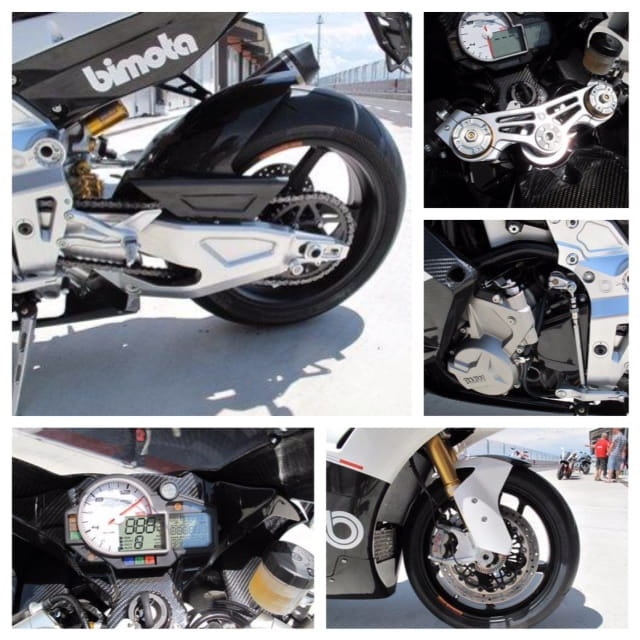
There’s certainly nothing wrong with the engine but the chassis just simply isn’t as well set-up as the bike it’s based on. You can pin an S1000RR on its ear, drag the footrest mid-corner and still feel like it’s laughing at you. I never once got the feeling from the Bimota that it would take the same abuse.
The end of the straight is flat in fourth gear, and roughly 160mph. You go down one gear, brake and then throw it in on its ear using the bike’s lean angle to slow it down on the way into the corner.
The first time I entered the corner fast on a hot tyre I missed the apex by about five feet as the bike wanted to push me to the edge of the track. There’s no in-between with it. It’s either right on its ear, or making clumsy diagonal lines around the track as the bike drops in and out of where it wants to sit. It’s not where you want to point it, that’s for sure.
The brakes worked well and the ABS rarely kicked-in. But get the bike hard into the turn and it feels like it wants to fall into corners like some sports bike used to do in the early 2000's. Things have moved on, perhaps Bimota hasn’t. I can’t help feeling that given more track time on the bike and by being more aggressive that it could have felt better, but, the Continental front tyres were getting torn up like they’d done a WSB race without even pushing too hard.
The front suspension feels very stable on the brakes, but it’s a bit harsh over bumps. The rear worked for me though allowing you to wind the bike up hard and getting all the traction control lights flashing out of every corner, partly because of the greasy track surface, partly because of the power of the bike.
Bimota certainly know how to make a bike handle, but the BB3 isn’t there yet.
To get to learn the track I took out the Ducati 1198-powered 162bhp Bimota DB9 for a few laps to get my eye in to the circuit. It had almost perfect manners. You could feel what it was doing on the way in and out of corners and it had the perfect amount of power for exiting every corner on the back wheel with a big grin, a load of V-twin boom and a big strip of rubber on the track,
On the exit of corners the BMW is incredibly fast and charges so fast up to 14,000 rpm you have to be fully dialled in to cope with the forces of acceleration. Get it picked up, get the throttle dialled-in and it accelerates so hard you have to have your wits about you. Sadly only being able to select ‘road mode’ meant it coughed and spluttered off the turn as the anti-wheelie kicked in and the traction control light stopped the tyre from spinning. Slick or Race mode would have stopped this.
It’s exciting to ride, an experience you won’t ever forget and you’re unlikely to see one parked up at your local meeting so there’s no worries about exclusivity. If that’s your thing then great. But if you really want to ride it, then think very hard. This is a motorcycle after all, not a show piece.
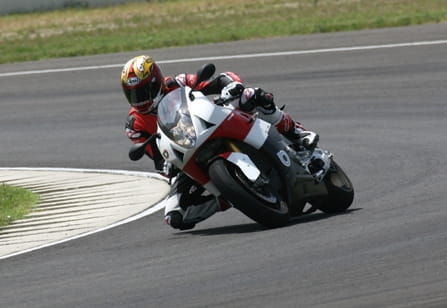
BUT IS BIMOTA STILL RELEVANT IN 2014?
So here’s the rub. What I am about to say means that I am unlikely to ever get invited back to a Bimota launch ever again, but it’s my job to report the facts as I see them.
As it is, the Bimota BB3 is obviously a sorted race bike in the hands of the Alstare team but as a £28,000 road bike it’s not good enough.
Passion and emotion is one thing, and you can argue all day long about the way it would draw a crowd if parked next to the bike it’s based on. In many ways it’s a stunning bike, but first of all Bimota need to make it work properly.
I admire the way the new owners kicked back at the Bimota Experience weekend with a beer and the owners played in their own band while entertaining Bimota customers. They genuinely care and looked as though they were loving being the new owners. Marco was even taking to the racetrack over the weekend in fully-branded Bimota leathers. I admire their passion, I admire the people and the emotion of the Bimota name.
Maybe it’s the Italian thoroughbred roots coming through, it needs careful handling like the best race horse or delicate old race bikes that require a lot of love to make them work. But there’s a very big but. That's but, not butt.
Bimota belongs to a time when they put big fat engines from bikes that didn’t handle to a chassis that transformed the bikes and made them look like nothing else.
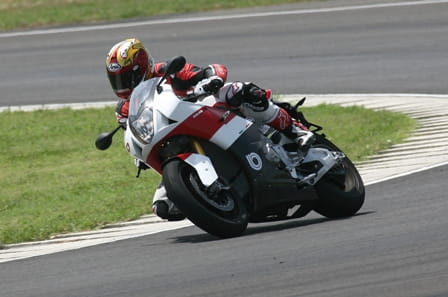
In the seventies and eighties, plenty of bikes didn’t handle properly back then, they do now.
I can’t help thinking that as much as I admire the innovation of the company over the years with bikes like the Tesi‘s and even the ill-fated Bimota V-Due which was recalled the moment it went on sale, can’t help thinking that the world doesn’t need Bimota any more. Like the difficult album from a great band who should know when to hang up their guitars, maybe it really is time for Bimota to have rethink.
Over my years as an MCN tester and journalist I’ve ridden most Bimota’s from the very first to the latest. From the two-stroke 500 V-due, to the original BB1, to the new DB9, from the Kawasaki Z1000-powered air/oil cooled KB1, the Honda 750-powered HB1, the GSX-R-powered SB6Rs, and pretty much everything in between.
I always feel like you should love them, and I come from a generation where I had a Bimota Tesi picture on my bedroom wall. I really want to love their bikes and be part of the Bimota family. But the truth is that of all the bikes I’ve ridden with a Bimota badge over the last 20 years, most of them didn’t work in one way or another, not one was as perfect as its looks might suggest.
There were four BB3’s at the Bimota Experience Weekend. They had a full back-up of Bimota mechanics looking after them and at least two of the four bikes were having ‘mystery electrical faults', spluttering down the straight and not picking up revs.
They’d come in, pull over and then an Italian rider would wave their arms and strop off, all European tempers at the ready.
The bikes were then getting pulled into the workshops for some fettling, before appearing later on working again. It went on like that all day. In theory, all the electronics are BMW, and this shouldn’t happen on a hand-built £28,000 bike with some of the best electronic systems available.
But beyond some teething trouble on the launch bikes, the chassis looks great yet feels out dated, the riding position is from another generation, the styling is where sports bikes were at five years ago, and the standard BMW S1000RR would ride around the outside of it all day long, and that’s before we get to the high-spec BMW HP4. I wish Bimota all the best and every success but I’m still struggling to see where this bike fits against things like the £54,000 Ducati Superleggera for instance, a bike as technically advanced as it gets yet that still manages to out-perform almost anything on the road.
So, Bimota then. Maybe I just expected too much from the reborn Bimota and the BB3, but at that price with a handbuilt bike, that history, and that engine, it should be the best sports bike in the world. It ain't.
Passion and emotion? They're just words. I’ll take a bike that works properly instead.









